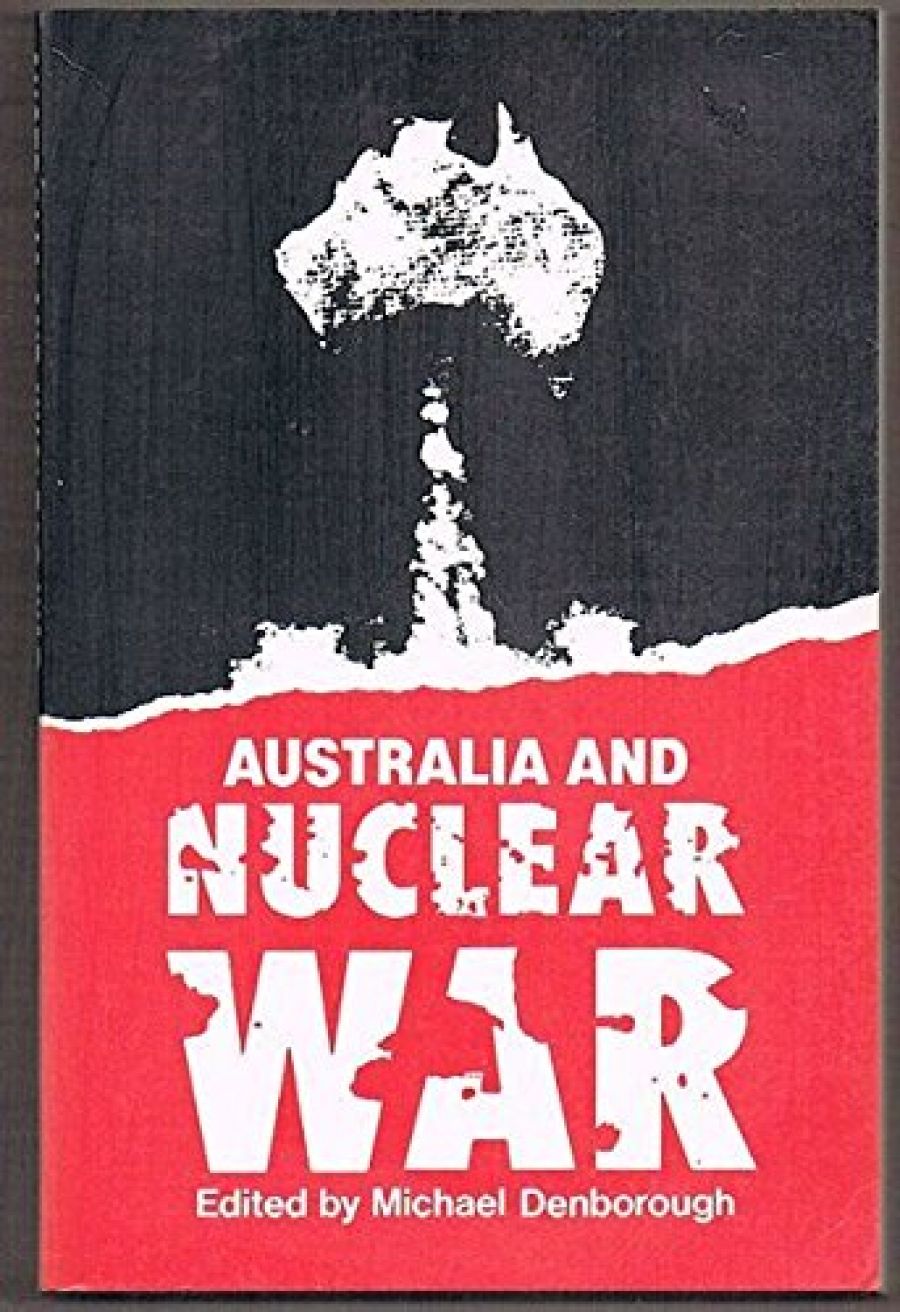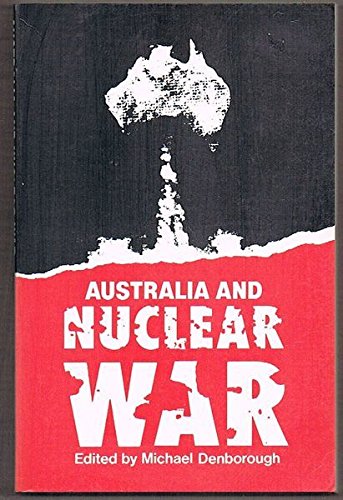
- Free Article: No
- Contents Category: History
- Review Article: Yes
- Article Title: Avoiding the burning
- Online Only: No
- Custom Highlight Text:
Anyone still worried about the military-industrial complex unveiled by Eisenhower at the end of his presidency can have their Angst updated with this disturbing book.
The present Republican commander-in-chief, with only the tinsel medals of Hollywood for his proud chest and a set role to play, is unlikely, even as a parting gesture, to use up prime time to let us in on how the robust infant of Eisenhower’s day has come of age and mutated with the times to become the fully-integrated military-industrial-academic-bureaucratic complex it is today.
Frank Barnaby, professor of peace studies at the Free University of Amsterdam and former head of the Swedish peace research centre, SIPRI, in the opening paper in this collection, ‘Will There Be A Nuclear War?, shows how powerful and well-entrenched this complex has become. Vast bureaucracies have grown up in the great powers to deal with military matters, and about 500,000 scientists, around 25 per cent of all scientists employed on research, work exclusively on military research.
- Book 1 Title: Australia and Nuclear War
- Book 1 Biblio: Croom Helm Australia, 270pp., index, $29.95, $12.95 pb 0 946614 05 X
- Book 1 Cover Small (400 x 600):

- Book 1 Cover (800 x 1200):

“Academics and bureaucrats join with the military and the weapons industry to form a giant academic-bureaucratic-military-industrial complex intent on maintaining and increasing military budgets and agitating for every conceivable technological advance for military purposes. This complex has so much political power as to be almost politically irresistible. If this is so, the nuclear arms race is now totally out of the control of political leaders. And this is as true in the Soviet Union as it is in the USA.”
Elsewhere in the book, Judy Irving and Heather Ogilvie, the former one of the makers of the film ‘Dark Circle’, take us to an arms convention where new weapons, both nuclear and non-nuclear, are sold with the same slick half-truths that prey on the same fears and obsessions that are exploited to sell household detergents; and former colonel David Hackworth, the most decorated soldier in US history, describes the fluid movement of personnel between the private defence industry and the US government, and the increasing militarisation of America, with key positions traditionally held by civilians being taken over more and more by generals. As an example of both trends he cites General Alexander Haig, who came from the defence contractor United Technology and returned there after his stint as secretary of state.
Barnaby argues that the present state of affairs can only be reversed if public opinion can be mobilised to the extent that it becomes strong enough to overcome the pressure exerted on the political leaders by the military-industrial-academic-bureaucratic complex.
He also describes in some detail the important qualitative advances in nuclear weaponry, improving the accuracy, reliability and targeting flexibility of nuclear weapon systems, and forming the basis for the shift in military and strategic thinking from the deterrence of mutually assured destruction to notions of nuclear-war fighting and nuclear-war winning.
With increasingly accurate weapons directed at military targets, the belief that both sides’ cities would inevitably be destroyed becomes less automatic, and the idea grows that it will be possible to destroy the enemy’s retaliatory capability by striking first. The cruise missiles currently being deployed in Europe reflect this changing strategy, being so accurate as to be perceived as nuclear-war fighting weapons, although Barnaby suggests that one of the main reasons for their deployment could be to provoke the USSR into heavy expenditure on counter-measures. Notwithstanding the fashionable right-wing rhetoric (which is echoed in the Australian government’s leaked strategic basis planning document) it is still the US that is ahead in military technology.
The book is a collection of sixteen papers presented at a symposium entitled ‘The Consequences of Nuclear War for Australia and its Region’ held at the ANU at the end of May 1983, and is an excellent guide to its subject, which is somewhat wider than the title suggests. As can be seen, the papers cover international issues as well as more directly Australian concerns. Contributors abroad apart from those mentioned include Bernard Feld professor of physics at Massachusetts Institute of Technology, Roland Vogt, West German MP from the Green Party, and Professor Oleg Gavrilov, chairman of the medical council in the USSR ministry of health.
Feld, who confesses to the ‘original sin’ of being part of the team which made the first nuclear weapons, gives a chilling account of the proliferation of nuclear weapons – “to sub-national groups and factions” as well as to many countries – that can be expected if the West continues to freely market nuclear power technology. Given a mere ten kilograms of reasonably pure plutonium, it requires what Feld calls “only a very low level of technical competence” to fashion a crude nuclear bomb powerful enough to destroy the centre of a major city.
He advocates a separation of the nuclear energy production process from the fuel fabrication and reprocessing aspects, with the latter being concentrated in a single centre controlled in Fort Knox-fashion, with fabricated and spent fuel elements being transported to and from the centre under guard.
The Australian contributors include the defence strategists Dr Desmond Ball and RH Mathams, Dr HC Coombs on the social and economic impact of nuclear war, Senator Susan Ryan, John Langmore, economic adviser to the treasurer, on the economic and social implications of military spending, contributors on the medical and atmospheric effects of nuclear war, including the editor, Dr Michael Denborough, Nancy Shelley on the role of women in the prevention of nuclear war, and last but not least, Patrick White, who received a standing ovation at the end of his paper, which later appeared in an abbreviated form in the Press.
Called ‘The Role of the Australian Citizen in a Nuclear War’, White’s paper is concerned mostly with the spiritual vacuousness in “this materialistic, muscular Australian society”. “Australians are not prepared for anguish”, he says. “I don’t mean only in the sense of personal bereavement,.but in the true spiritual sense, when we feel that God may have forsaken the world.” By contrast, Senator Ryan’s paper is essentially a politician’s address, a feminist apology for the government’s defence policies.
The strategic basis document leaked to the National Times was presumably in the course of preparation at the time of the symposium, and according to the official list of participants some eight representatives of the defence department were in attendance. The cabinet meeting that accepted the document took place in Perth, the area of potentially the highest casualties in the event of an attack on US-related defence establishments. (In the case of Perth, the naval base at Cockburn Sound.)
According to Ball and Mathams, in the event of a major “nuclear engagement” between the US and the USSR, “it is likely that the joint US/Australian facilities at North West Cape, Pine Gap and Nurrungar would be attacked with nuclear weapons; nuclear attacks against Cockburn Sound and Darwin would be less likely and may occur only if appreciable use of their facilities was being made by US naval and air forces; nuclear attacks against Australian urban-industrial centres would seem to be most unlikely”.
There is a divergence between the contributors as to the conclusions to be drawn from the state of the nuclear arsenals of the superpowers, and this bears upon the relative likelihood of potential Australian targets being fired upon. Barnaby describes the massive “overkill” capacity of America and the Soviet Union, “much larger than needed for any conceivable military, political or strategic reason”, with their combined nuclear arsenals possessing an explosive power 750 times greater than all the high explosives used in all the wars in history. Ball and Mathams on the other hand suggest as one of the reasons for the generally low priority they give to secondary Australian targets, the fact that with losses from attrition and malfunction Soviet warheads would more likely be allocated to higher priority targets.
Dr Coombs suggests an alternative scenario, with key installations in Australia being attacked as an alternative to a direct attack on the US, as a demonstration of capability, but not so as to provoke a full American response, on the reasoning that “Australian lives would be regarded as expendable: perhaps a plausible hypothesis”. With the experience of many years service as a senior government official, Coombs cautions against being able to count on “great and powerful friends”.
Coombs is not altogether happy with his own subject and writes with a wry irony of such matters as the effects a nuclear war would have on exports. But if there is one glaring omission from Coombs’ paper (and from the book) it is his failure to discuss the effects a nuclear war would have on sport. What would become of the Olympic Games? Could one-day cricket and the international tennis circuit survive? And who could poor Michelle Ford aspire to swim against after a nuclear war?
Surely any book concerned with the consequences of a nuclear war for Australia should attempt to answer such questions.


Comments powered by CComment